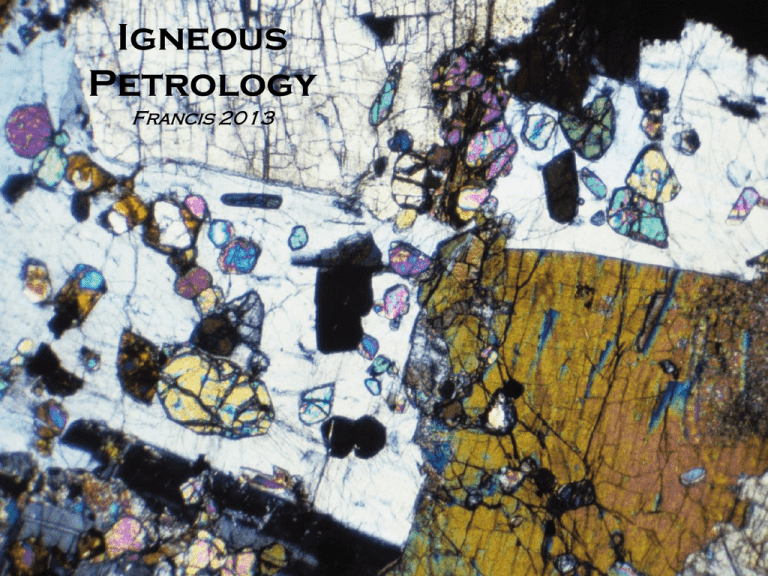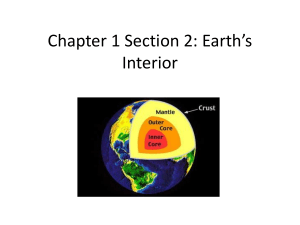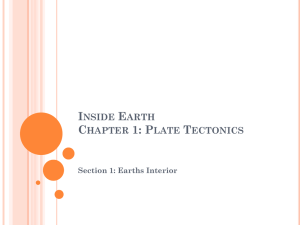IgneousPet423-13Intro
advertisement

Igneous Petrology Francis 2013 Igneous Petrology: EPSC 423A, 2013 donald.francis@mcgill.ca Lectures: Tues & Thurs: 11:30 - 12:30 pm Room: FDA 315 Lab: Thursday 2:30-5:30pm Documents: www.eps.mcgill.ca/~courses/c423/ Topics: The Nature of Silicate Melts Review of Thermodynamics and Simple Phase Diagrams Phase Equilibria in Complex Systems at elevated P-T Role of Volatiles Behaviour of Trace Elements Implications of Isotopes Crust / Mantle Reservoirs Fractionation Processes Mid-Ocean Ridge Basalts Ocean Island Basalt Suites Flood Basalt Volcanism Calc-Alkaline Magmatism Ultra-Potassic and Carbonatitic Magmatism Troctolite - Anorthosite Magmatic Suites Komatiites and Archean Greenstone - Tonalite Terranes Magmatism on the Moon, Venus, and Mars Grading: Final Theory Exam Lab Reports 50% 50% TA’s: Grant Cox Ryan Libbey Jason Coumans - FDA 311 (grant.cox@mail.mcgill.ca) - FDA 312 (ryan.libbey@mail.mcgill.ca) - FDA 202a (jason.coumans@mail.mcgill.ca) Labs – reports worth 50% A typed report will be required for each lab, typically due the following Thursday before the next Lab. You Will Work in Teams of ~2 1. 2. 3. 4. 5. 6. 7. 8. 9. 10. 11. 12. Review of Common Rock Forming Minerals Meteorites and the Mantle Volcanic Textures, Cooling Rates, and Primary Magmas Classification of Basalts: Baffin Island and Fort Selkirk Plutonic Equivalents: The Monteregian Hills (with associated field trip) Small Intrusions – the Dash Dyke Large Layered Intrusions – Muskox, Bushveld, Raudot. Graphical & Numerical Analysis of Crystal Fractionation Eocene Calc-Alkaline Volcanism Eocene Granitoid Plutonism Kimberlites, carbonatites, and other exotica Precambrian greenstones and granitoids NB: Get Microscope and download AlphaMelts program during the first lab, Thursday, Sept. 5. All questions such as: my microscope does not work, where are the thin sections, who has the rock samples, etc. should be directed to the TA’s. Francis, Igneous Petrology EPSC 423A, 2013 Field Trip Saturday, Oct. 5 Mount St. Hilaire The Monteregian Hills Rougemont Mount Yamaska References on Reserve in PSE Library and/or my Office Theory: Winter, J.D.; 2001: An Introduction to Igneous and Metamorphic Petrology. Prentice Hall, QE461.W735 2001. Philpotts,A.R., & Ague, J.J.; 2009: Priciples of Igneous and Metamorphic Petrology. Cambridge University Press, QE461.P572 Ehlers, E.G.; 1972: The Interpretation of Geological Phase Diagrams. Freeman, San Francisco, QE364 E35 Rocks in Thin Section: Nesse, W.D., 2004: Introduction to Optical Mineralogy, 348p. Oxford University, Press, QE369.06 N47 Williams, H., Turner, F.J., & Gilbert, C.M.; 1982: Petrography: An introduction to the study of rocks in thin section. Freeman, San Francisco, QE434 W73. Francis, Igneous Petrology EPSC 423A, 2013 Required Component of Course Outlines Jane Everett, Dean of Students. Language: In accord with McGill University’s Charter of Students’ Rights, students in this course have the right to submit in English or in French any written work that is to be graded. Integrity: McGill University values academic integrity. Therefore all students must understand the meaning and consequences of cheating, plagiarism and other academic offences under the Code of Student Conduct and Disciplinary Procedures (seewww.mcgill.ca/students/srr/honest/ for more information). Francis, Igneous Petrology EPSC 423A, 2013 Igneous Petrology The study of rocks that form by the: crystallization of a cooling melt (“liquid”) or magma Fundamental challenge : to understand high temperature crystal-liquid processes by studying cold solid rocks Francis, Igneous Petrology EPSC 423A, 2013 Diversity of igneous rocks reflects the action of crystal – liquid fractionation processes at high temperature Solid(xyl) K Liquid(liq) glass Elemental partitioning between coexisting solid and liquid Cxyli / Cliqi = Ki followed by the physical separation of solid(s) and liquid 0livine constant temperature (Fe/Mg)oliv / (Fe/Mg)liq ~ 0.3 Francis, Igneous Petrology EPSC 423A, 2013 Two Kinds of Igneous Rocks: White/Light Granitoids: light or felsic rocks dominated by feldspar and quartz that Granite Constitute the continental crust. Black/Dark Basalt/gabbro: dark or mafic rocks dominated by Fe-Mg silicates, such as olivine, and pyroxenes. Basalt Constitute the oceanic crust. Igneous Rocks reflect magmatic processes in an evolving Earth Francis, Igneous Petrology EPSC 423A, 2013 Composition of the Sun and the Cosmic Abundances of the Elements: The Sun constitutes 99.98 wt.% of the solar system, thus the chemical composition of the Sun is also that of the solar system. To determine the proportion of the elements in the Sun, we make use of the energy levels between the electron orbitals of the atoms of the different elements. The electromagnetic spectra of the Sun was noted to contain dark lines in 1802 by Wollaston and later studied by Fraunhofer (early 1800's), indicating adsorption at selective wavelengths or energies. Radiation emerging from the Sun's interior passes though the gas of its photosphere (outermost visible layer), in which the different elements selectively absorb radiation whose wavelength corresponds to the difference in the energy (E = hc/l) levels of its electron orbitals. The intensity of the absorption lines is a measure of the proportion of each element. Francis, Igneous Petrology EPSC 423A, 2013 Solar Spectrum The Sun constitutes 99.98 wt.% of the solar system, thus the chemical composition of the Sun is also that of the solar system. O, Si, Mg, Fe constitute more than 91% of Condensed Sun’s Composition >92% Major Elements Chondritic Meteorites have the same solid composition as the Sun ~ Solar System Francis, Igneous Petrology EPSC 423A, 2013 Mantle Xenoliths: Olivine – rich Peridotite nodules of the Earth’s mantle brought to the surface by volcanoes. Francis, Igneous Petrology EPSC 423A, 2013 Sun - Chondritic Meteorites - Earth’s Mantle Sun ~ BulkSilicateEarth (~68 wt.%) + Fe-metal core (~31 wt.%) The Earth’s upper mantle is similar in composition to BSE, and is composed of a rock called peridotite, which consists largely of the minerals olivine and orthopyroxene basalt or granite crust peridotite mantle Fe-Ni metallic core Francis, Igneous Petrology EPSC 423A, 2013 SiO2 + MgO + FeO ~ 91% basalt or granite crust feldspar peridotite mantle Iron olivine Chondritic Meteorite = Sun + Iron Metal Mantle Xenoliths Francis, Igneous Petrology EPSC 423A, 2013 Terrestrial Planets basalt or granite crust peridotite mantle Crust represents only ~0.7 wt.% of the Earth Fe-Ni metallic core Francis, Igneous Petrology EPSC 423A, 2013 Mantle Ocean Continent crust crust SiO2 TiO2 Al2O3 MgO FeO CaO Na2O K2O Total 45.2 0.7 3.5 37.5 8.5 3.1 0.6 0.1 99.2 49.4 1.4 15.4 7.6 10.1 12.5 2.6 0.3 99.3 60.3 1.0 15.6 3.9 7.2 5.8 3.2 2.5 99.5 Cations normalized to 100 cations Si Ti Al Mg Fe Ca Na K O 38.5 0.5 3.6 47.6 6.0 2.8 0.9 0.1 140.2 46.1 1.0 16.9 10.6 7.9 12.5 4.7 0.5 153.0 56.4 0.7 17.2 5.4 5.6 5.8 5.8 3.0 161.3 Mineralogy (oxygen units, XFe3+ = 0.10) Quartz Feldspar Clinopyroxene Orthopyroxene Olivine Oxides 0.0 13.2 6.7 18.3 59.9 1.8 0.0 57.3 25.7 4.1 9.9 3.0 13.0 64.3 5.9 14.7 0.0 2.0 Oceanic crust - MORB basalt Continental crust - granite p e Francis, Igneous Petrology EPSC 423A, 2013 Partial Melting of the Mantle Solid Source Fertile Mantle Cpx-rich Peridotite Lherzolite Refractory Solid Restite + Refractory Mantle + Olivine-rich Peridotite Harzburgite Liquid Oceanic Crust + Basalt Whole = Σ Parts Lever Rule: p/R = x/y amount of basalt (P) in fertile mantle = x/(x+y) y ~ 15-20% x R Francis, Igneous Petrology EPSC 423A, 2013 Crystal Fractionation of Basalt Parent Magma Crystal Cumulate + Residual Magma Plutonic or Intrusive Rocks Mafic Magma Volcanic Rocks Gabbroic Cumulate + Felsic Magma Whole = Σ Parts Lever Rule: e/C = x/y Volcanic rocks approximate the compositions of magmatic liquids. They represent aliquots of liquid that have escaped to the surface. The compositional variation observed in the liquids that the volcanic rocks represent is produced by varying degrees of crystal fractionation of a largely “gabbroic” mineral assemblage that now comprises plutonic intrusions. Francis, Igneous Petrology EPSC 423A, 2013 amount of granite in basalt = x/(x+y) Cx ~ 10% y Continental Crustal Granitoids Second Stage Melting of Basalt The majority of crustal granitoids are, however, thought to be liquids produced at the eutectic point e by the second stage melting of silicasaturated basaltic/gabbroic mafic crust, consisting largely of pyroxene and plagioclase. Francis, Igneous Petrology EPSC 423A, 2013 e Mantle Ocean Continent crust crust SiO2 TiO2 Al2O3 MgO FeO CaO Na2O K2O Total 45.2 0.7 3.5 37.5 8.5 3.1 0.6 0.1 99.2 49.4 1.4 15.4 7.6 10.1 12.5 2.6 0.3 99.3 60.3 1.0 15.6 3.9 7.2 5.8 3.2 2.5 99.5 Spectrum of Igneous liquids Cations normalized to 100 cations Si Ti Al Mg Fe Ca Na K O 38.5 0.5 3.6 47.6 6.0 2.8 0.9 0.1 140.2 46.1 1.0 16.9 10.6 7.9 12.5 4.7 0.5 153.0 56.4 0.7 17.2 5.4 5.6 5.8 5.8 3.0 161.3 Mineralogy (oxygen units, XFe3+ = 0.10) Quartz Feldspar Clinopyroxene Orthopyroxene Olivine Oxides 0.0 13.2 6.7 18.3 59.9 1.8 0.0 57.3 25.7 4.1 9.9 3.0 13.0 64.3 5.9 14.7 0.0 2.0 Oceanic crust - MORB basalt Continental crust - granite p e Francis, Igneous Petrology EPSC 423A, 2013








